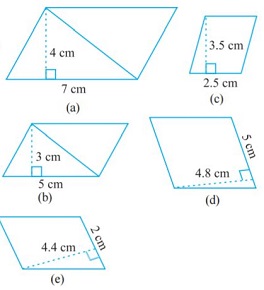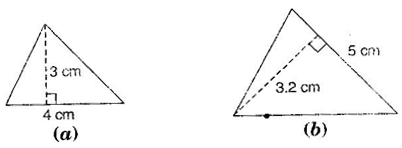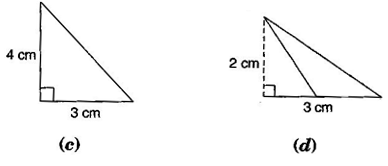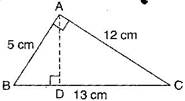Perimeter and Area - Solutions 2
CBSE Class –VII Mathematics
NCERT Solutions
Chapter 11 Perimeter and Area (Ex. 11.2)
NCERT Solutions
Chapter 11 Perimeter and Area (Ex. 11.2)
Question 1. Find the area of each of the following parallelograms:

Answer: We know that the area of parallelogram = base x height
(a) Here base = 7 cm and height = 4 cm
∴ Area of parallelogram = 7 x 4 = 28 cm2
(b) Here base = 5 cm and height = 3 cm
∴ Area of parallelogram = 5 x 3 = 15 cm2
(c) Here base = 2.5 cm and height = 3.5 cm
∴ Area of parallelogram = 2.5 x 3.5 = 8.75 cm2
(d) Here base = 5 cm and height = 4.8 cm
∴ Area of parallelogram = 5 x 4.8 = 24 cm2
(e) Here base = 2 cm and height = 4.4 cm
∴ Area of parallelogram = 2 x 4.4 = 8.8 cm2
Question 2. Find the area of each of the following triangles:


Answer: We know that the area of triangle = 12 x base x height


Answer: We know that the area of triangle = 12 x base x height
(a) Here, base = 4 cm and height = 3 cm
∴ Area of triangle = 12 x 4 x 3 = 6 cm2
(b) Here, base = 5 cm and height = 3.2 cm
∴ Area of triangle = 12 x 5 x 3.2 = 8 cm2
(c) Here, base = 3 cm and height = 4 cm
∴ Area of triangle = 12 x 3 x 4 = 6 cm2
(d) Here, base = 3 cm and height = 2 cm
∴ Area of triangle = 12 x 3 x 2 = 3 cm2
Question 3. Find the missing values:
S. No.
|
Base
|
Height
|
Area of the parallelogram
|
a.
|
20 cm
|
246 cm2
| |
b.
|
15 cm
|
154.5 cm2
| |
c.
|
8.4 cm
|
48.72 cm2
| |
d.
|
15.6 cm
|
16.38 cm2
|
Answer: We know that the area of parallelogram = base x height
(a) Here, base = 20 cm and area = 246 cm2
∴ Area of parallelogram = base x height
⇒ 246 = 20 x height ⇒ height = 24620 = 12.3 cm
(b) Here, height = 15 cm and area = 154.5 cm2
∴ Area of parallelogram = base x height
⇒ 154.5 = base x 15 ⇒ base = 154.515 = 10.3 cm
(c) Here, height = 8.4 cm and area = 48.72 cm2
∴ Area of parallelogram = base x height
⇒ 48.72 = base x 8.4 ⇒ base = 48.728.4 = 5.8 cm
(d) Here, base = 15.6 cm and area = 16.38 cm2
∴ Area of parallelogram = base x height
⇒ 16.38 = 15.6 x height ⇒ height = 16.3815.6 = 1.05 cm
Thus, the missing values are:
S. No.
|
Base
|
Height
|
Area of the parallelogram
|
a.
|
20 cm
|
12.3 cm
|
246 cm2
|
b.
|
10.3 cm
|
15 cm
|
154.5 cm2
|
c.
|
5.8 cm
|
8.4 cm
|
48.72 cm2
|
d.
|
15.6 cm
|
1.05
|
16.38 cm2
|
Question 4. Find the missing values:
Base
|
Height
|
Area of triangle
|
15 cm
|
---
|
87 cm2
|
---
|
31.4 mm
|
1256 mm2
|
22 cm
|
---
|
170.5 cm2
|
Answer: We know that the area of triangle = 12 x base x height
In first row, base = 15 cm and area = 87 cm2
∴ 87 = 12 x 15 x height ⇒ height = 87×215 = 11.6 cm
In second row, height = 31.4 mm and area = 1256 mm2
∴ 1256 = 12 x base x 31.4 ⇒ base = 1256×231.4 = 80 mm
In third row, base = 22 cm and area = 170.5 cm2
∴ 170.5 = 12 x 22 x height ⇒ height = 170.5×222 = 15.5 cm
Thus, the missing values are:
Base
|
Height
|
Area of triangle
|
15 cm
|
11.6 cm
|
87 cm2
|
80 mm
|
31.4 mm
|
1256 mm2
|
22 cm
|
15.5 cm
|
170.5 cm2
|
Question 5. PQRS is a parallelogram. QM is the height from Q to SR and QN is the height from Q to PS. If SR = 12 cm and QM = 7.6 cm. Find:
(a) the area of the parallelogram PQRS
(b) QN, if PS = 8 cm
Answer: Given: SR = 12 cm, QM= 7.6 cm, PS = 8 cm.
(a) Area of parallelogram = base x height = 12 x 7.6 = 91.2 cm2
(b) Area of parallelogram = base x height
⇒ 91.2 = 8 x QN ⇒ QN = 91.28 = 11.4 cm
Question 6. DL and BM are the heights on sides AB and AD respectively of parallelogram ABCD. If the area of the parallelogram is 1470 cm2, AB = 35 cm and AD = 49 cm, find the length of BM and DL.

Answer: Given: Area of parallelogram = 1470 cm2
Base (AB) = 35 cm and base (AD) = 49 cm
Since Area of parallelogram = base x height
⇒ 1470 = 35 x DL ⇒ DL = 147035 = 42 cm
Again, Area of parallelogram = base x height
⇒ 1470 = 49 x BM ⇒ BM = 147049 = 30 cm
Thus, the lengths of DL and BM are 42 cm and 30 cm respectively.
Question 7. ΔABC is right angled at A. AD is perpendicular to BC. If AB = 5 cm, BC = 13 cm and AC = 12 cm, find the area of ΔABC. Also, find the length of AD.

Answer: In right angled triangle BAC, AB = 5 cm and AC = 12 cm
Area of triangle = 12 x base x height = 12 x AB x AC = 12 x 5 x 12 = 30 cm2
Now, in ΔABC,
Area of triangle ABC = 12 x BC x AD
⇒ 30 = 12 x 13 x AD ⇒ AD = 30×213 = 6013 cm
Question 8. ΔABC is isosceles with AB = AC = 7.5 cm and BC = 9 cm. The height AD from A to BC, is 6 cm. Find the area of ΔABC. What will be the height from C to AB i.e., CE?

Answer: In ΔABC, AD = 6 cm and BC = 9 cm
Area of triangle = 12 x base x height = 12 x BC x AD = 12 x 9 x 6 = 27 cm2
Again, Area of triangle = 12 x base x height = 12 x AB x CE
⇒ 27 = 12 x 7.5 x CE ⇒ CE = 27×27.5 = 7.2 cm
Thus, height from C to AB i.e., CE is 7.2 cm.
